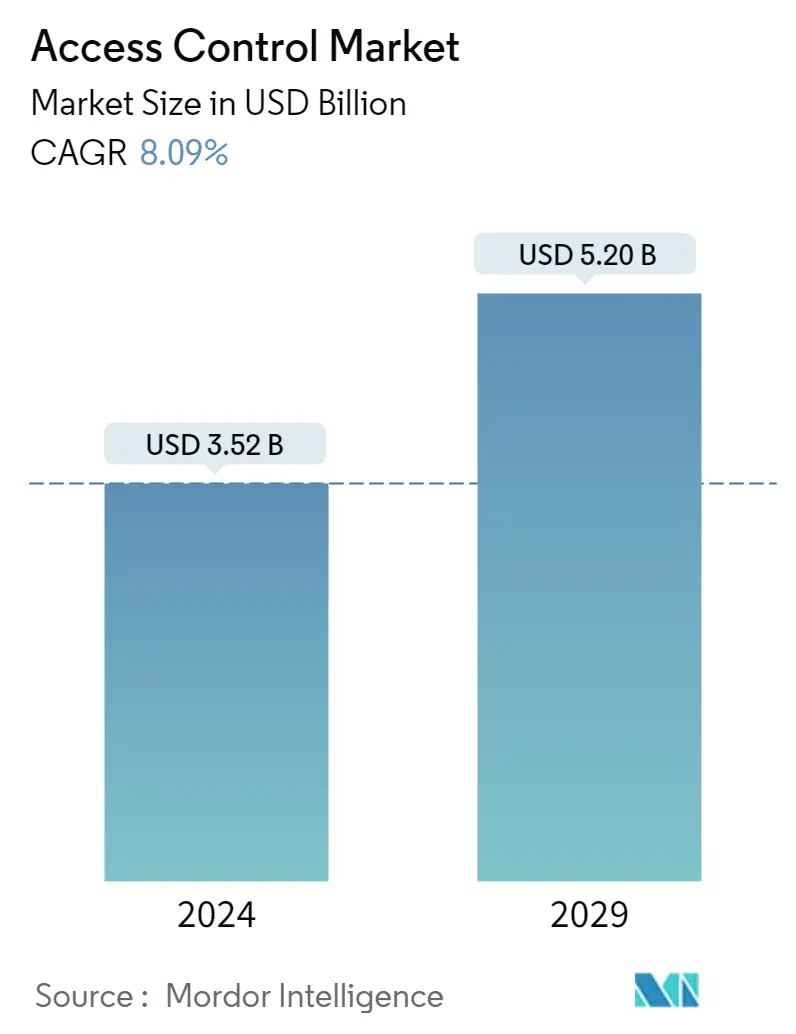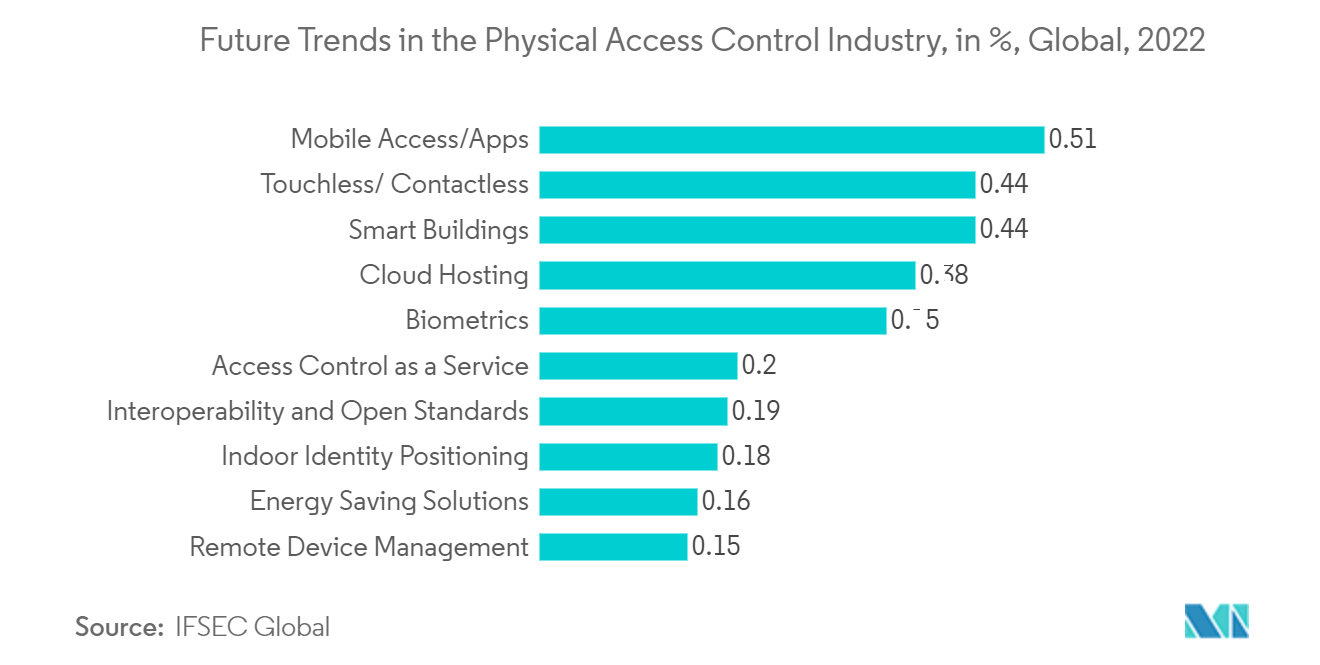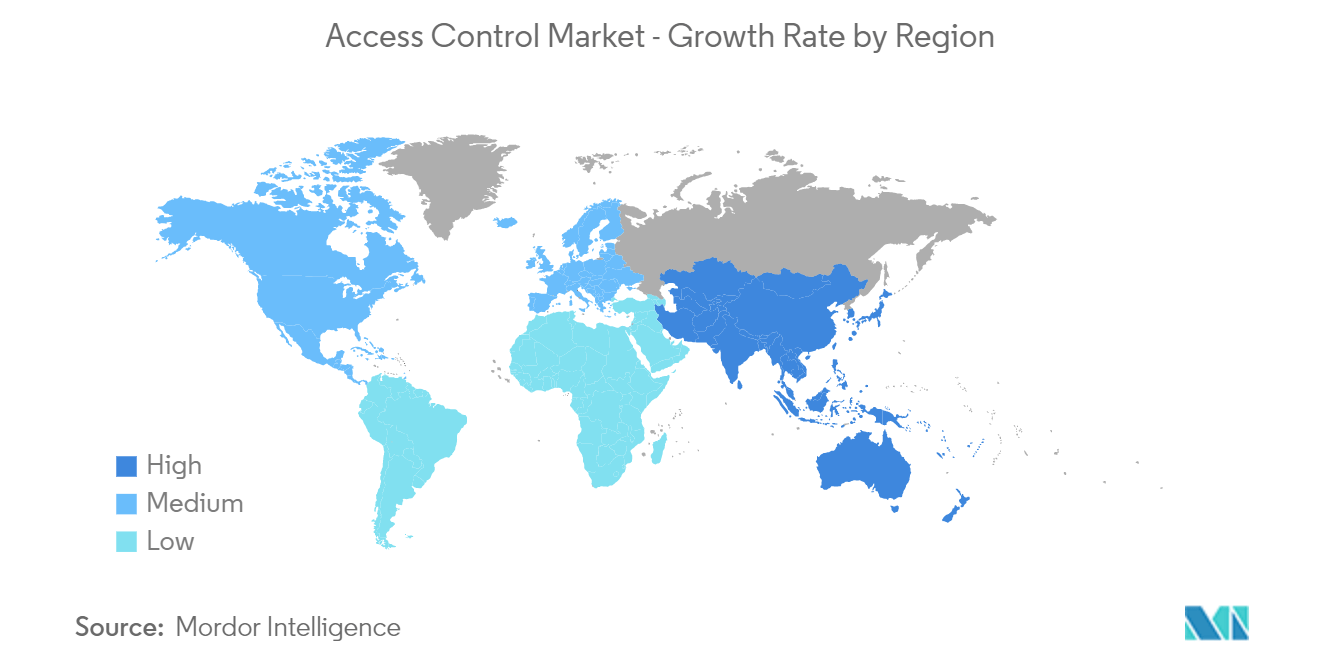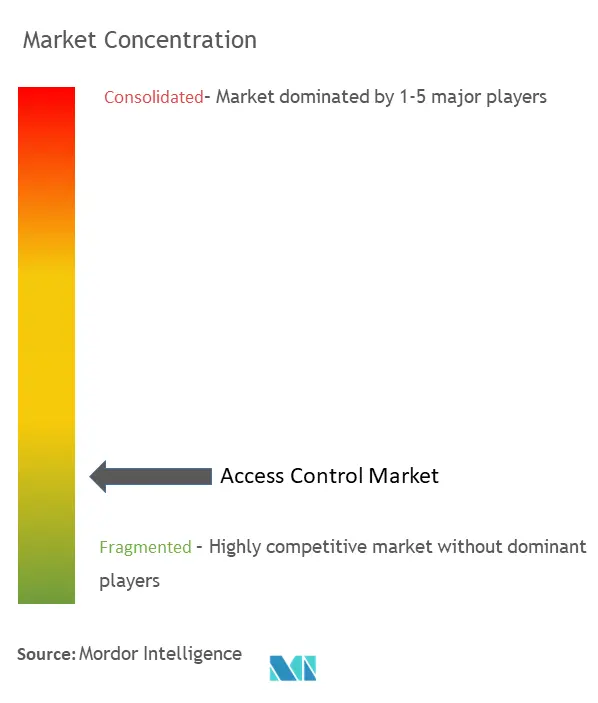Access Control Market Size

| Study Period | 2019 - 2029 |
| Market Size (2024) | USD 3.52 Billion |
| Market Size (2029) | USD 5.20 Billion |
| CAGR (2024 - 2029) | 8.09 % |
| Fastest Growing Market | Asia Pacific |
| Largest Market | North America |
Major Players
*Disclaimer: Major Players sorted in no particular order |
Access Control Market Analysis
The Access Control Market size is estimated at USD 3.52 billion in 2024, and is expected to reach USD 5.20 billion by 2029, growing at a CAGR of 8.09% during the forecast period (2024-2029).
- The access control market is experiencing significant growth, with a valuation of USD 8.64 billion in the previous year, and it is projected to reach USD 13.43 billion over the forecast period. The increasing availability of biometric equipment drives this growth, particularly fingerprint recognition, which is cost-effective and widely used. The market is also benefiting from the growing interconnectedness of devices and rising security risks.
- The Internet of Things (IoT) has played a crucial role in enhancing the efficiency and automation of security systems, enabling secure data exchange, and connecting smart objects to the Internet. Cloud-based communication has made remote monitoring of critical areas possible, and password authentication is being used to secure IoT-based security systems. This has led to the adoption of IoT-based solutions in various areas, such as smart alarm systems and garage door openers, replacing traditional processes in many businesses.
- Cyber and physical integration has brought significant benefits to access control technology. Physical and cyber access controls now function seamlessly, providing users with converged credentials, reducing the risk of lost credentials, and eliminating the need for complex passwords. As a result, the demand for access control systems is expected to increase due to the rapid transformation of the security industry, the introduction of wireless access points and cloud computing, and the growing popularity of smart infrastructure projects.
- Modern access control systems use technologies such as biometrics, RF, Bluetooth, NFC, and near-field communication. However, the need for testing, training, and implementation costs can deter end-users from adopting these systems. The lack of public awareness and operational concerns regarding newly created wireless locks and their expanded benefits when combined with the cloud poses a barrier to the expansion of this market.
- The global pandemic has also impacted access control systems, with growing use for monitoring occupancy data to enforce safety procedures. This has led to more complex and challenging requirements for security, facilities, and IT teams to manage as remote working has become more prevalent. As a result, the IT industry is expanding its security approaches and capabilities rapidly, with a growing demand for sophisticated authentication and technology to protect valuables and sensitive data. This is expected to accelerate the widespread adoption of advanced authentication techniques in the future.
Access Control Market Trends
Commercial Segment to Hold Major Market Share
- Access control systems have become the preferred way to manage access to commercial buildings, offices, and businesses. These systems offer enhanced property security and convenience for tenants and staff, who can easily enter with a credential while denying access to unauthorized individuals. Access control systems can also provide a way for visitors to request property access from tenants.
- Employee theft is a significant issue that creates a demand for access control systems. According to an article by CompareCamp, global loss from fraud and employee theft is estimated to be USD 2.9 trillion annually, and 33% of corporate bankruptcies in the United States are linked to employee theft. Deploying access control systems can effectively reduce employee theft by permitting or denying entry to individuals with a key card.
- Access control systems can be built to restrict physical access to IT rooms where sensitive information is stored. Different access control systems come with various identification protocols, such as smart card identification, biometric identification, mobile access identification, and proximity identification.
- Advancements in wireless technology have enhanced wireless hardware components such as locks and controllers, reducing the need for physical cables and conduits. Cloud technology services are also reducing the requirement for servers and software, facilitating secure remote access.
- The market for access control systems is expected to grow due to increasing safety consciousness, the growing demand for high-level access control systems, and the adoption of access control devices in commercial organizations.

Asia Pacific to Witness Significant Growth
- In the Asia-Pacific region, China continues to dominate the market, mainly due to its expanding construction sector, a large number of manufacturing industries, and a growing crime rate. The adoption of mobile-based access control solutions is also on the rise in the country. China's smart door lock segment has grown exponentially in recent years, driven by advancements in biometric recognition and wireless communication technologies.
- In Japan, the security aspect of access control solutions has gained significant interest from the government and enterprises, leading to the establishment of new legislation, strategies, and facilities. Japanese companies are actively researching and developing newer biometric and authentication devices that enable a touchless experience.
- India is witnessing a surge in the deployment of access control solutions in various sectors, including data centers, office premises, hotels, retail stores, and government institutions, primarily due to the rapidly growing security concerns and increasing crime rates.
- South Korea is making significant efforts to advance digital transformation in the country, with initiatives such as the Korea Digital Development initiative and digital government strategy for 2021-2025. Contactless technology and solutions, such as facial recognition and fingerprint locks, are emerging rapidly in the country, driven by the government's strong will to foster contactless technologies.
- Other countries in the Asia-Pacific region, such as Australia and Singapore, are also witnessing a rise in the adoption of access control solutions, driven by the rising IoT technologies and the necessity for protections against COVID-19. These solutions are seen as a means to support safe and secure social infrastructure as the digital revolution of facility management continues to propel forward.

Access Control Industry Overview
The access control market is highly competitive and comprised of both global and regional players striving for a larger share in a fiercely contested space. Despite the high barriers to entry, several new entrants have successfully made a mark in the market. Some of the notable players in the industry include Suprema Inc., Hanwha Vision (formerly known as Hanwha Techwin Co. Ltd), Thales Group (Gemalto NV), Bosch Security System Inc., Honeywell International Inc., and others.
In March 2023, Hanwha Techwin was rebranded as Hanwha Vision, signaling the start of the company's journey to become a global vision solution provider. The company aims to leverage its core strengths and vision technology to offer innovative solutions that solve the challenges faced by its customers and create new value.
In October 2022, ASSA ABLOY AB completed the acquisition of ALCEA, a French-based access control solutions provider. ALCEA will be integrated into ASSA ABLOY's Critical Infrastructure business portfolio, enabling the company to enhance its presence in critical infrastructure protection environments and expand its product access-centered product portfolio. This acquisition is in line with the company's strategic vision to strengthen its position in the access control market.
Access Control Market Leaders
-
Suprema Inc.
-
Hanwha Techwin Co. Ltd
-
Thales Group (Gemalto NV)
-
Bosch Security System Inc.
-
Honeywell International Inc
*Disclaimer: Major Players sorted in no particular order

Access Control Market News
- March 2023: In Axis Communications and Genetec Inc. partnered to launch Axis, an enterprise-level access control solution that combines Genetec access control software and Axis network door controllers in a single, easy-to-deploy package. This solution is the first of its kind on the market and utilizes Genetec technology to provide unified security, public safety, operations, and business intelligence solutions.
- February 2023: Air Canada announced a new digital facial recognition pilot program for selected flights between Vancouver and Winnipeg, as well as for qualified customers at the Air Canada Café at Toronto Pearson International Airport. The airline claims to be the first in Canada to offer this technology to its customers. The program aims to streamline the boarding process, reduce wait times, and increase efficiency. Air Canada plans to eventually extend this service to a few Canadian airports and Maple Leaf Lounges.
Access Control Market Report - Table of Contents
1. INTRODUCTION
- 1.1 Study Assumptions and Market Definition
- 1.2 Scope of the Study
2. RESEARCH METHODOLOGY
3. EXECUTIVE SUMMARY
4. MARKET INSIGHTS
- 4.1 Market Overview
-
4.2 Industry Attractiveness - Porter's Five Forces Analysis
- 4.2.1 Bargaining Power of Suppliers
- 4.2.2 Bargaining Power of Buyers
- 4.2.3 Threat of New Entrants
- 4.2.4 Intensity of Competitive Rivalry
- 4.2.5 Threat of Substitutes
- 4.3 Industry Value Chain Analysis
- 4.4 Assessment of the Impact of COVID-19 on the Industry
5. MARKET DYNAMICS
-
5.1 Market Drivers
- 5.1.1 Growing Adoption of Access Control Systems owing to Rising Crime Rates and Threats
- 5.1.2 Technological Advancements
-
5.2 Market Challenges
- 5.2.1 Operational and ROI Concerns
6. TECHNOLOGY SNAPSHOT
- 6.1 Evolution of Access Control Solutions
- 6.2 Comparative Analysis of RFID and NFC Technology
- 6.3 Key Technological Trends
7. MARKET SEGMENTATION
-
7.1 By Type
- 7.1.1 Card Reader and Access Control Devices
- 7.1.1.1 Card-based
- 7.1.1.2 Proximity
- 7.1.1.3 Smart Card (Contact and Contactless)
- 7.1.2 Biometric Readers
- 7.1.3 Electronic Locks
- 7.1.4 Software
- 7.1.5 Other Types
-
7.2 By End User Vertical
- 7.2.1 Commercial
- 7.2.2 Residential
- 7.2.3 Government
- 7.2.4 Industrial
- 7.2.5 Transport and Logistics
- 7.2.6 Healthcare
- 7.2.7 Military and Defense
- 7.2.8 Other End User Verticals
-
7.3 By Geography
- 7.3.1 North America
- 7.3.1.1 United States
- 7.3.1.2 Canada
- 7.3.2 Europe
- 7.3.2.1 United Kingdom
- 7.3.2.2 Germany
- 7.3.2.3 France
- 7.3.2.4 Rest of the Europe
- 7.3.3 Asia Pacific
- 7.3.3.1 China
- 7.3.3.2 Japan
- 7.3.3.3 India
- 7.3.3.4 South Korea
- 7.3.3.5 Rest of the Asia Pacific
- 7.3.4 Rest of the World
8. COMPETITIVE LANDSCAPE
-
8.1 Company Profiles
- 8.1.1 Suprema Inc.
- 8.1.2 Hanwha Techwin Co. Ltd
- 8.1.3 Thales Group (Gemalto NV)
- 8.1.4 Bosch Security System Inc.
- 8.1.5 Honeywell International Inc
- 8.1.6 Tyco International Plc (Johnson Controls)
- 8.1.7 Allegion PLC
- 8.1.8 ASSA ABLOY AB Group
- 8.1.9 Schneider Electric SE
- 8.1.10 Panasonic Corporation
- 8.1.11 Brivo Systems, LLC
- 8.1.12 Identiv, Inc.
- 8.1.13 Nedap NV
- 8.1.14 Dormakaba Holding AG
- 8.1.15 NEC Corporation
- 8.1.16 Idemia Group
- 8.1.17 Axis Communications AB
- *List Not Exhaustive
9. INVESTMENT ANALYSIS
10. FUTURE OF THE MARKET
** Subject To AvailablityAccess Control Industry Segmentation
Access control products allow the end-users to authenticate the personnel accessing an organization's physical infrastructure. Securing a location, such as a building, parking lot, or office space, is known as physical access control. A physical access control system (PACS) is frequently installed to oversee and enforce physical security. PACS shields areas of a building or its grounds from unauthorized access.
The access control market is segmented by type (card reader & access control devices (card-based, proximity, smart card (contact and contactless)), biometric readers, electronic locks, and software), end-user vertical (commercial, residential, government, industrial, transport & logistics, healthcare, and military & defense) and geography(North America (United States, Canada), Europe (United Kingdom, Germany, France, Rest of Europe), Asia Pacific (China, Japan, India, South Korea, Rest of Asia Pacific), and the rest of the world). The market sizes and forecasts are provided in terms of value (USD) for all the segments.
| By Type | Card Reader and Access Control Devices | Card-based |
| Proximity | ||
| Smart Card (Contact and Contactless) | ||
| By Type | Biometric Readers | |
| Electronic Locks | ||
| Software | ||
| Other Types | ||
| By End User Vertical | Commercial | |
| Residential | ||
| Government | ||
| Industrial | ||
| Transport and Logistics | ||
| Healthcare | ||
| Military and Defense | ||
| Other End User Verticals | ||
| By Geography | North America | United States |
| Canada | ||
| By Geography | Europe | United Kingdom |
| Germany | ||
| France | ||
| Rest of the Europe | ||
| By Geography | Asia Pacific | China |
| Japan | ||
| India | ||
| South Korea | ||
| Rest of the Asia Pacific | ||
| By Geography | Rest of the World |
Access Control Market Research FAQs
How big is the Access Control Market?
The Access Control Market size is expected to reach USD 3.52 billion in 2024 and grow at a CAGR of 8.09% to reach USD 5.20 billion by 2029.
What is the current Access Control Market size?
In 2024, the Access Control Market size is expected to reach USD 3.52 billion.
Who are the key players in Access Control Market?
Suprema Inc., Hanwha Techwin Co. Ltd, Thales Group (Gemalto NV), Bosch Security System Inc. and Honeywell International Inc are the major companies operating in the Access Control Market.
Which is the fastest growing region in Access Control Market?
Asia Pacific is estimated to grow at the highest CAGR over the forecast period (2024-2029).
Which region has the biggest share in Access Control Market?
In 2024, the North America accounts for the largest market share in Access Control Market.
What years does this Access Control Market cover, and what was the market size in 2023?
In 2023, the Access Control Market size was estimated at USD 3.26 billion. The report covers the Access Control Market historical market size for years: 2019, 2020, 2021, 2022 and 2023. The report also forecasts the Access Control Market size for years: 2024, 2025, 2026, 2027, 2028 and 2029.
What are the key drivers of the Access Control Market?
Key factors driving the Access Control Market are a) Heightened security concerns b) Technological advancements c) Increasing adoption of IoT-based security systems
Access Control Industry Report
The access control market is witnessing significant growth, driven by the escalating demand for advanced security systems across various sectors including commercial, residential, industrial, and homeland security. Key technologies such as biometric systems, smart cards, and cloud-based solutions are enhancing security and convenience, while the integration of IoT and mobile-based technologies allows for remote management and monitoring. Access control manufacturers are innovating to cater to the diverse needs of these industries, thereby expanding the access control market size. Market statistics indicate a positive trajectory in market share, size, and revenue growth, supported by the continuous need for sophisticated security solutions and technological advancements. For a detailed analysis, including a market forecast and historical overview, download a free report PDF from Mordor Intelligence™ Industry Reports on access control statistics. This comprehensive insight helps stakeholders understand the current trends and future outlook of the access control market.



